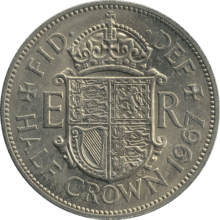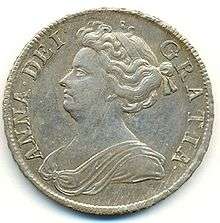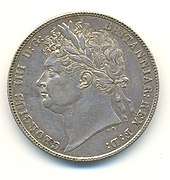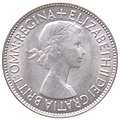Half crown (British coin)
The half crown was a denomination of British money, equivalent to two shillings and sixpence, or one-eighth of a pound. The half crown was first issued in 1549, in the reign of Edward VI. No half crowns were issued in the reign of Mary, but from the reign of Elizabeth I half crowns were issued in every reign except Edward VIII, until the coins were discontinued in 1970.
United Kingdom | |
| Value | 1⁄8 pound sterling |
|---|---|
| Mass | (1816–1970) 14.14 g |
| Diameter | (1816–1970) 32.31 mm |
| Edge | Milled |
| Composition | (1816–1919) 92.5% Ag (1920–1946) 50% Ag (1947–1970) Cupronickel |
| Years of minting | 1707–1970 |
| Obverse | |
 | |
| Design | Profile of the monarch (Elizabeth II design shown) |
| Designer | Mary Gillick |
| Design date | 1953 |
| Reverse | |
 | |
| Design | Various (crowned Royal Shield shown) |
| Designer | Edgar Fuller and Cecil Thomas |
| Design date | 1967 |
The half crown was demonetised (ahead of other pre-decimal coins) on 1 January 1970, the year before the United Kingdom adopted decimal currency on Decimal Day. During the English Interregnum of 1649–1660, a republican half crown was issued, bearing the arms of the Commonwealth of England, despite monarchist associations of the coin's name. When Oliver Cromwell was made Lord Protector of England, half crowns were issued bearing his semi-royal portrait. The half crown did not display its value on the reverse until 1893.
Because the pound sterling was worth four US dollars in the first half of the twentieth century the half-crown was often referred to, even until it was withdrawn, as "half a dollar".
History of the half crown by reign
_(FindID_734368).jpg)

- King Henry VIII 1526: the first English half crown was struck in gold.
- King Edward VI 1551: issued the first half crown in silver. The coin was dated and showed the king riding a horse.
- Queen Mary I: the half crown was struck on Mary's marriage to Philip II of Spain in 1554 but was never issued for circulation. Three specimens exist. http://www.petitioncrown.com/spare15_LK47.html
- Queen Elizabeth I: gold half crowns were issued again. At the end of the reign silver half crowns were issued.
- King James I: gold half crowns were issued again. During the reign silver half crowns were issued.
- King Charles I: silver half crowns were issued, including those struck as obsidional money, money of necessity during the Civil War period.
- Commonwealth of England: Oliver Cromwell silver half crowns were issued. During the years 1656 and 1658 milled half crowns were issued of Oliver Cromwell.
- King Charles II 1663–1685: silver half crowns were issued, and this period saw the end of the hammered issue of half crowns.
- King James II 1685–1688: silver half crown.
- King William III & Queen Mary II 1689–1694: silver half crown.
- William III of England 1694–1702: silver half crown.
- Queen Anne 1702–1714: silver half crown.
- King George I 1714–1727: silver half crown.
- King George II 1727–1760: silver half crown.
- King George III 1760–1820: silver half crown.
- King George IV 1820–1830: silver half crown.
- King William IV 1830–1837: silver half crown.
- Queen Victoria 1837–1901: silver half crown.
- King Edward VII 1902–1910: silver half crown.
- King George V 1910–1936: silver half crown, sterling silver (92½% silver) until 1919, then 50% silver.
- King Edward VIII 1936: 50% silver half crown. Not issued for circulation.
- King George VI 1937–1952: 50% silver half crowns were issued until 1946 when the metal was changed to cupro-nickel.
- Queen Elizabeth II 1952–1970: the last half crown was issued in 1970 shortly before decimalisation.
Size and weight
From 1816, in the reign of George III, half crown coins had a diameter of 32 mm and a weight of 14.14 grams (defined as 5⁄11 troy ounce[1]), dimensions which remained the same for the half crown until decimalisation in 1971.[2]
Mintages
The mintage figures below are taken from the annual UK publication COIN YEARBOOK.[3] Proof mintages are indicated in italics.
| Victoria | (Jubilee) | |||
| 1887 | 1,438,046 1,084 |
1890 | 3,228,111 | |
| 1888 | 1,428,787 |
1891 | 2,284,632 | |
| 1889 | 4,811,954 |
1892 | 1,710,946 | |
| Victoria | (Old Head) | |||
| 1893 | 1,792,600 1,312 |
1898 | 1,870,055 | |
| 1894 | 1,524,960 |
1899 | 2,865,872 | |
| 1895 | 1,772,662 |
1900 | 4,479,128 | |
| 1896 | 2,148,505 |
1901 | 1,516,570 | |
| 1897 | 1,678,643 |
|||
| Edward VII | ||||
| 1902 | 1,316,008 15,123 |
1907 | 3,693,930 | |
| 1903 | 274,840 |
1908 | 1,758,889 | |
| 1904 | 709,652 |
1909 | 3,051,592 | |
| 1905 | 166,008 |
1910 | 2,557,685 | |
| 1906 | 2,886,206 |
|||
| George V | ||||
| 1911 | 2,914,573 6,007 |
1924 | 5,866,294 | |
| 1912 | 4,700,789 |
1925 | 1,413,461 | |
| 1913 | 4,090,169 |
1926 | 4,473,516 | |
| 1914 | 18,333,003 |
1927 | 6,837,872 15,000 | |
| 1915 | 32,433,066 |
1928 | 18,762,727 | |
| 1916 | 29,530,020 |
1929 | 17,632,636 | |
| 1917 | 11,172,052 |
1930 | 809,051 | |
| 1918 | 29,079,592 |
1931 | 11,264,468 | |
| 1919 | 10,266,737 |
1932 | 4,793,643 | |
| 1920 | 17,982,077 |
1933 | 10,311,494 | |
| 1921 | 23,677,889 |
1934 | 2,422,399 | |
| 1922 | 16,396,724 |
1935 | 7,022,216 | |
| 1923 | 26,308,526 |
1936 | 7,039,423 | |
| George VI | ||||
| 1937 | 9,106,440 26,402 |
1945 | 19,849,242 | |
| 1938 | 6,426,478 |
1946 | 22,724,873 | |
| 1939 | 15,478,635 |
1947 | 21,911,484 | |
| 1940 | 17,948,439 |
1948 | 71,164,703 | |
| 1941 | 15,773,984 |
1949 | 28,272,512 | |
| 1942 | 31,220,090 |
1950 | 28,335,500 17,513 | |
| 1943 | 15,462,875 |
1951 | 9,003,520 20,000 | |
| 1944 | 15,255,165 |
1952 | 1[4] | |
| Elizabeth II | ||||
| 1953 | 4,333,214 40,000 |
1961 | 25,887,897 | |
| 1954 | 11,614,953 |
1962 | 24,013,312 | |
| 1955 | 23,628,726 |
1963 | 17,625,200 | |
| 1956 | 33,934,909 |
1964 | 5,973,600 | |
| 1957 | 34,200,563 |
1965 | 9,778,440 | |
| 1958 | 15,745,668 |
1966 | 13,375,200 | |
| 1959 | 9,028,844 |
1967 | 33,058,400 | |
| 1960 | 19,929,191 |
1970 | 750,000 |
Gallery
_MET_DP100457.jpg) Edward VI half-crown, 1552
Edward VI half-crown, 1552.jpg) Gold half crown of James I
Gold half crown of James I.jpg) Charles I half-crown
Charles I half-crown Half crown coin of Oliver Cromwell, 1658
Half crown coin of Oliver Cromwell, 1658 Half crown of Charles II, 1680
Half crown of Charles II, 1680.jpg) Half crown of James II, 1687
Half crown of James II, 1687 Half crown of 1691: William III and Mary II
Half crown of 1691: William III and Mary II_(FindID_795243).jpg) Half crown of William III, 1696
Half crown of William III, 1696 Half crown of Queen Anne
Half crown of Queen Anne Half crown of George II, 1746
Half crown of George II, 1746 Half crown of George III, 1816
Half crown of George III, 1816 Half crown of George IV, 1821
Half crown of George IV, 1821 Half crown of William IV, 1836
Half crown of William IV, 1836 Half-crown of Victoria, 1885
Half-crown of Victoria, 1885 Half-crown of Victoria, 1888
Half-crown of Victoria, 1888- The reverse of the 1905, Edward VII, half crown.
 George V half crown, 1930
George V half crown, 1930 George VI half crown, 1948
George VI half crown, 1948 The obverse of the 1953, Elizabeth II, half crown.
The obverse of the 1953, Elizabeth II, half crown. The reverse of the 1953, Elizabeth II, half crown.
The reverse of the 1953, Elizabeth II, half crown.
See also
References
- Kindleberger, Charles P. (2005). A Financial History of Western Europe. Taylor & Francis. p. 60.
- Tony Clayton. "Coins of the UK - Thirty Pence". coins-of-the-uk.co.uk.
- "Coin, Banknote and Medal Collector's Magazines. Token Publishing Numismatic Interest". tokenpublishing.com.
- "Welcome to Colin Cooke Coins - Numismatics, Coins, Rarities - 1952 Halfcrown". colincooke.com.
External links
- - View coins from the Commonwealth of England period, 1649–1660, including halfcrowns.
- British Coins - Free information about British coins (from 1656 to 1952). Includes an online forum.
- Coins of the UK - A full history of the half crown.
- - Publishers of COIN YEARBOOK (mintage figure source)
- The History of the Half-crown
- Halfcrown, Coin Type from United Kingdom - Online Coin Club
.png)